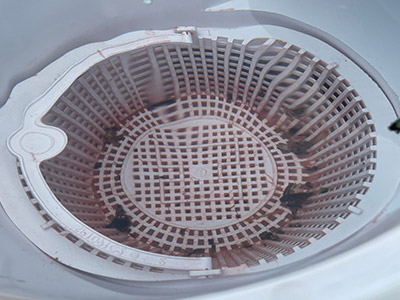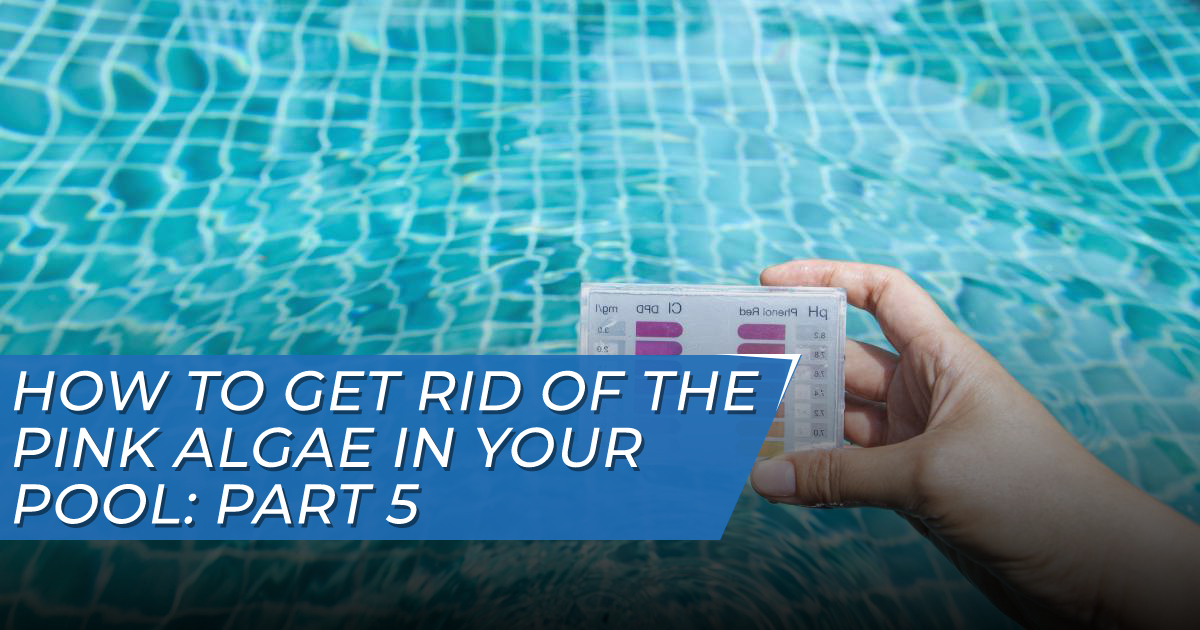How To Get Rid Of The Pink Algae In Your Pool: Part 5
Pink algae in a pool form a slimy pink or clear layer over the pool’s surfaces and fixtures and can manifest as reddish or pink streaks, usually growing alongside white water mold. It’s prone to growing on PVC materials, from which pool materials are often made. This type of algae loves to grow in areas of the swimming pool that experience minimal sunlight and water movement, so removing it from your pool can be challenging.
Related article: Swimming Pool Chemicals for Beginners
What Is Pink Algae in a Pool?

Sometimes called pink slime, pink algae is not algae at all — it’s bacteria. The pink color comes from pigments within its cells, and the slime that forms around the bacteria is a mechanism to protect it from external threats. This is a naturally occurring problem, and these microorganisms can grow anywhere there’s water, including swimming pools.
Related Article: How to Maintain a Swimming Pool: Getting the Chemistry Right
Is pink algae in a pool dangerous?
Pink algae may be unsightly, but it doesn’t pose a threat to your health. It isn’t a pathogen, which means if you have pink algae in your pool, it won’t harm your health. However, having slippery pool fixtures can contribute to accidents, so getting rid of pink algae is vital to maintaining the overall safety of your pool.
Why do I have pink algae in my swimming pool?
There’s no single cause of pink algae in swimming pools, but a number of factors can contribute to the appearance of this nuisance:
Poor water circulation
When pool water isn’t circulating as it should, organic contaminants like oils, skin cells, and leaf litter can provide a food source for this pink algae. Consider turning on your pool filter for longer periods of time, and clearing out skimmers and filters more frequently.
Imbalanced water chemistry
Low chlorine levels and improperly balanced pH, alkalinity, and sanitizer may all encourage bacterial buildup. Regularly testing and balancing your water chemistry can help eliminate pink algae from your swimming pool. This may be especially after periods of heavy rainfall.
Environmental factors
Direct sunlight can kill the bacteria responsible for pink algae in your pool, so trimming branches above your pool may destroy this unsightly slime. Ideally, your pool surfaces should receive at least six hours of direct sun exposure each day to deter the presence of pink algae. Since these microorganisms thrive in warm, humid conditions, you may notice higher pink algae levels during summer months.
Related article: How To Maintain a Swimming Pool: Getting the Chemistry Right
How To Get Rid Of Pink Algae In Your Pool
As is the case with most algae, prevention is the best cure, and maintaining your pool’s chemical balance is your most potent weapon against pink algae. While treating your pool with chlorine and bromine helps kill other types of germs and bacteria, pink algae is very resistant to those chemicals.
Despite regular maintenance and chemical treatment, pink algae can still develop in your pool. It can survive on items like pool toys, skimmer baskets, fountains, and even garden hoses, so the chance of recontamination is high. Here are our top tips for eliminating pink algae from your pool:
1. Physically cleaning your pool
Regularly brushing and vacuuming your pool surfaces — and covering your pool when it rains — can decrease the chance of a pink algae infestation. But don’t forget to remove the cover during sunny days, even if you don’t plan to swim. Sunlight and UV rays are natural oxidizers and help prevent pink algae growth.
Remember to look for it not just in your pool but other areas and items nearby your pool area that may be damp and dark, like storage containers for pool toys, garden hoses, etc.
2. Use an appropriate algaecide
Certain algaecides contain antibacterial properties that can help eliminate pink algae from your pool. A professional company can recommend and administer them to rid your pool of this unwanted invader.
3. Pool shocking
Regular pool-shocking and cleaning may also prevent pink algae from forming in your pool; however, if pink algae are already present and visible, there are some steps you can take to get rid of it. Although resistant to chlorine and bromine, it is not entirely unaffected by it. The high amounts of chemicals present when shocking a pool is part of the treatment of pink algae.
4. Filter continuously for 24 hours
After a thorough pool shock, running your filter for a full 24 hours will ensure the appropriate chemicals reach each and every corner of your pool, helping kill any remains of pink algae.
GPS Pools can help you eliminate pink algae
Eradicating pink algae from your pool can be a lengthy process, and our professional, certified pool technicians can help you remove it and teach you how to prevent future outbreaks. Each pool is different, and we offer personalized pool cleaning services to resolve any issues that may arise. Contact us today to get started!
Be sure to check out the rest of our blogs in this 5 part Pool Algae Series:
How To Get Rid Of The Algae In Your Pool: Part 1 The Basics
How To Get Rid Of The Green Algae In Your Pool: Part 2
How To Get Rid Of The Black Algae In Your Pool: Part 3
How To Get Rid Of The Yellow Algae In Your Pool: Part 4

